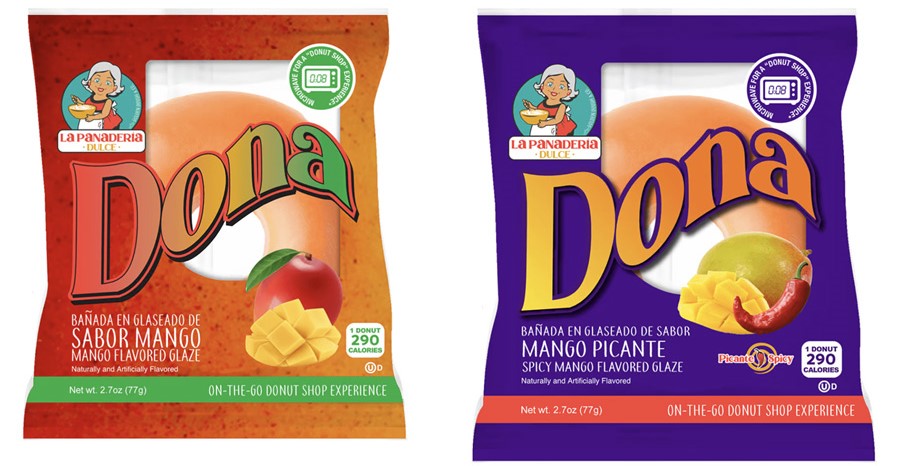The Bottom Line:
- Overall sweet-good sales increasing
- Consumers crave a combination of flavor innovation and familiarity
- Private-label producers continue to see success
Nothing says “reward” quite like a sweet baked good. After several years of overcoming near-herculean challenges—plague, war, and, if not outright famine, at least persistent supply shortages—it’s only fair that the sweet-goods sector received a reward of its own this past year: strong sales.
Market data
Just ask Wil Torres: “The whole category seems to be booming,” enthuses the founder, CEO, and CVO of Golden Dough Foods, Winter Park, FL.
And the 52 weeks ending March 26, 2023, were indeed sweet for sweet goods, with everything from pastries, Danishes and coffee cakes to doughnuts, brownies, muffins, and more posting gains over the period, per Circana (Chicago) OmniMarket Integrated Fresh data.
Source: Circana OmniMarket™ Total Store View | Geography : Total US - Multi Outlet w/ C-Store (Grocery, Drug, Mass Market, Convenience, Military and Select Club & Dollar Retailers) | Time : Latest 52 Weeks Ending 03-26-23
For example, pastry/Danish/coffee cake sales rose both in the store’s center and its perimeter, with the items registering $1.3 billion on 11.2% growth in the former and $1.8 billion on 9.5% growth in the latter.
In the sweet rolls space, three brands dominated the center store, with top-seller McKee Foods raking in $347.8 million on growth of 33.7% and second-place Hostess Brands banking $82.1 million on a year-to-year dip of 18.6%. Flowers Foods rounded out the podium with a $74.98 million take on 14.9% growth.
Bon Appetit Bakery clinched the top spot in center-store Danish sales by ringing up $192.2 million on 16.5% growth, while Starbucks Coffee Company made an appearance in fourth, generating $8.45 million on 10.2% growth.
Familiar brands—Hostess, Flowers, McKee, Bon Appetit—all landed high in the center-store coffee cake and crumb cake rankings, but only Flowers Foods, in third with $16.8 million in sales, actually posted growth, and of 7% at that.
For more robust center-store growth, look to Hispanic pastries, which saw sales increase 22.1% to $79.7 million, and had Grupo Bimbo to thank for $39.6 million of that till, on growth of 11.5%.
By contrast, turnovers and strudels barely made a blip in the center store, with the former bringing in $352,510—a 54.4% decline over the previous-year sales—and the latter barely raking in $50,415, down 77.5%.
The perimeter strudel and turnover scene was a different matter altogether, with perimeter turnovers turning over $160.16 million worth of product on 16.3% growth, and perimeter strudels packing in $67.8 million, up 14.4% on the year.
Private-label manufacturers dominated perimeter pastry/Danish/coffee-cake activity, contributing more than half to the perimeter sales totals for sweet-rolls ($266.4 million on growth of 10.3%), Danishes ($294.15 million on growth of 15.2%), pastries ($197.7 million on growth of 8.3%), Hispanic pastries ($55.7 million on declines of 28.4%), and coffee and crumb cakes ($178.5 million on growth of 8.1%).
And in perimeter brownies, private labels led the rankings again, adding $274.6 million on 14.9% growth to a total perimeter brownie take of $371.5 million.
Leading center-store brownie sales was McKee Foods, whose $313.3 million take was up 15.8% over the previous year. Coming in a distant but strong second was Grupo Bimbo, which saw its center-store brownie sales climb 18.0% to $85.4 million.
As for bars and squares, the store’s perimeter courted more traffic than its center, with the former bringing in $15.9 million on 22.6% growth and the latter ringing up $9.8 million on growth of 46.4%. Again, private label ruled the perimeter, accounting for a whopping $15.5 million of the category total, reflecting growth of 24.4%.
In the doughnut world, center-store sales were strong, topping out at $2.1 billion and reflecting growth of 17.1%. Full-size doughnuts generated most of that traffic, with Hostess Brands LLC taking the lead at $668.5 million in sales on 19.7% growth.
Despite a sales declines of 2.0%, JAB Holding (parent of Krispy Kreme) still clinched first place in center-store doughnut-hole sales with its take of $68.6 million. In center-store mini doughnuts, plaudits go to Grupo Bimbo in first, with sales of $2.8 million on an 11.2% decline.
In the perimeter, private-label doughnuts ran rings around the competition, accounting for $632.98 million of the perimeter’s full-size doughnut take of $657.8 million on growth of 20.2%, and $122.01 million of its doughnut-hole total of $124.4 million on 17.8% growth.
And that perennial perimeter favorite—the muffin—lifted sales 19.7% to $1.2 billion around the store’s edge. As with doughnuts, it was all private label, all the time, too, topping the ranks in full-size muffins ($925.4 million in sales at 18.8% growth), minis ($139.4 million at 27.9% growth), assorted and multipack ($67.2 million at 19.9% growth), and trays ($667,268 at 31.1% growth).
Looking back
Sales like that almost make COVID’s tribulations seem like ancient history—but only almost, for some pandemic patterns persist.
Take supply-chain snafus. “It certainly has been a hectic few years,” admits Kevin Ly, director of R&D/innovation, Ly Brothers/Sugar Bowl Bakery, San Francisco, CA. “But thankfully, the supply chain continues to recover. Unfortunately, commodity prices remain very elevated, led by eggs, butter, and sugar. But at least availability has become more reliable.”
Such was not always the case with sunflower oil and lecithin, which until recently had all but disappeared from the market courtesy of Russia’s invasion of Ukraine (the countries collectively lead the world in sunflower production).
“Like everyone else, we had to manage through these challenges,” recalls Paul Stippich, director of marketing, Otis Spunkmeyer, San Leandro, CA. “But fortunately, Otis Spunkmeyer uses sunflower oil and lecithin very minimally, and our well-established relationships with suppliers helped us navigate ingredient shortages.”
Golden Dough Foods, Winter Park, FL, also cultivated strong supplier relationships that not only ensured the company access to key materials but allowed it to purchase goods in higher quantities for better cost ratios, too, notes Torres.
Advantaging the company further still were its investments in technologies that improved operational efficiencies, trimmed waste, and lessened inflation’s sting. Thus, reflects Torres, “Our adaptability and willingness to innovate let us navigate post-COVID challenges successfully to keep providing customers with the delicious baked goods they love.”
But even with COVID in the rearview, some pandemic-inspired adaptations remain, including demand for individually wrapped sweet goods. Initially adopted as a safety hedge against potential cross contamination, they’ve stuck around because they now address a fresher problem, Stippich says: “The labor challenges that c-store, instore bakery and foodservice operators are experiencing.”

Also, Stippich suspects that the upheavals of the past few years have brought out a conservative streak in brands’ flavor innovation, with many “sticking to the basics,” he says. He points to a 2021 Technomic survey that ranked chocolate and chocolate chip consumers’ top flavor choices—still. Similarly, he says that blueberry maintains its most-favored-flavor status in the muffin space.
So while the Otis Spunkmeyer team is “keeping an eye toward the future of flavor development” Stippich says, “we also want to bring consumers new varieties of the familiar flavors they know and crave.”
Familiarity has bred success for Sugar Bowl Bakery, too, especially when it plays on seasonal traditions. As Ly observes, “While seasonal flavors aren’t new, it seems the programs our customers drive are bigger than ever.”
Case in point: “Pumpkin leads the way in fall,” he says, “when we see incredible interest in our pumpkin madeleines. When spring and summer hit, we see a shift toward our mango cakes and pineapple-coconut bites, which capitalize on textural variety with real pieces of fruit embedded in the batter. And in winter our peppermint-duet bites also hit the textural theme with peppermint candy pieces spread throughout a dual batter of vanilla cake and brownie—the perfect bite to enjoy while cozying up by the fireplace.”
Viewing the flavor landscape through a more forward-looking lens, Torres notes “the rejuvenation of innovation and mashups—I’m seeing a lot of sweet-and-savory combinations, and in our case, we launched a couple of nontraditional doughnut flavors with ‘sweet-heat’ SKUs in our hot-honey glazed and spicy-mango offerings.”
Looking forward
And that’s just the start for the company. In addition to “a really cool brand partnership with a mid-2023 launch,” Torres teases, “Golden Dough will soon go live with a cinnamon-roll glazed doughnut and more made using a technology that lets the company create sturdier glazes.”
As Torres explains, “Most of the individually wrapped chocolate doughnuts on the market are chocolate-enrobed, which has a waxier mouthfeel and—let’s face it—isn’t really chocolate.” But the chocolate glaze the technology lets the producer create is “a true standout”: Not only does it contain real cocoa for a real-chocolate taste, he says; it also clings to the product even at high temperatures.
“That’s key,” Torres emphasizes, “especially in a chocolate glaze. With many other doughnuts, honey buns, et cetera, the glaze or enrobing melts off, creating damp packaging. Our technology is such that the glaze stays stable.”
If only prices would do the same—if not actually fall. But inflation may be here at least for the near-term, per the experts, and it all makes Torres wax nostalgic.
“I remember when I first launched Krispy Kreme in 2016,” he recalls. “Buyers at wholesale and retail looked at me sideways when I shared our wholesale cost. They’d say, ‘That’ll be a $1.99 retail—nobody’s ever gonna buy a doughnut or honey bun for that!’ Well, here we are at $2.29 to $3.50. And sure, it’s crazy if you ask me, but the cost and landscape of doing business have changed. That said, I’m seeing both unit and dollar volumes up.”
“Consumers are still indulging,” corroborates Stippich. But, he continues, “They’re more cautious about which items they choose. They may purchase sweet baked goods at c-stores, where price points are lower than at bakeries, for example. And at restaurants, instead of ordering a higher-priced individually portioned dessert, they might opt for something shareable for the table.”
And he bets shareable treats will persist as both a “community dining experience” with a preferable price proposition and as a low-labor menu solution for operators. Otis Spunkmeyer is even bullish on the staying power of individually wrapped sweet goods, and will soon add just such a brownie to its individually wrapped cookies.After all, though spending dynamics are evolving, they’re not on the edge of a revolution. “Consumers will continue purchasing sweet baked goods both away from home and for the home,” Stippich predicts. “They’ll select high-quality core baked goods in the highest-value channels. But they won’t trade out of the category.”
NEW SWEET GOODS PRODUCTS on snackandbakery.com
Hostess Brands Mini Donuts/Baby Bundts
Tastykake football-themed snacks
Discover More New Products at snackandbakery.com/newproducts









